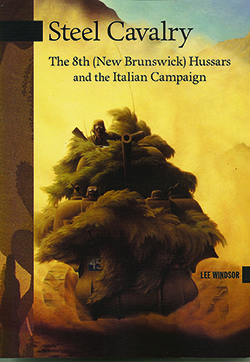Book Reviews

Book Cover – Steel Cavalry
Steel Cavalry ~
The 8th (New Brunswick) Hussars and the Italian Campaign
by Dr. Lee A. Windsor
Fredericton, NB: Goose Lane Editions, 2011
199 pages, $18.95
ISBN: 978-0-86492-657-9
For more information on accessing this file, please visit our help page.
Reviewed by Michael Cessford
Dr. Windsor, a military historian of note and a former Hussar himself, is well qualified to pen this history of the service of the 8th (New Brunswick) Hussars in Italy during the Second World War. In addition to his impressive academic credentials and a growing and highly-regarded record of publications, he has, as well, seen contemporary conflict first hand, having observed, in 2007, the operations of the Canadian Joint Task Force in Kandahar Province, Afghanistan.
It is important to begin by defining what this book is and is not. Steel Cavalry does not aspire to be an overly detailed or academic analysis of the combat operations of a Canadian armoured regiment in Italy in the Second World War. Rather, as one of the volumes of the New Brunswick Military Heritage Series, it seeks to provide the lay reader a sense, in just under 170 pages of text, of the experiences of a provincial militia unit that was mobilized as a motorcycle regiment in 1940, was converted to tanks a year later, and then, that same year, was sent overseas as a unit of the 5th Canadian Armoured Division. The 5th Division deployed into Italy, as part of the 1st Canadian Corps, late in 1943, saw its first combat along the static Ortona front, and then fought in two major offensives in 1944: Diadem (the breaking of the Hitler Line and attack into the Liri Valley) and Olive (the penetration of the Gothic Line, and the drive into the Romagna Plain).
Dr. Windsor makes effective use of first-person accounts to provide vivid and compelling images of Hussars engaged in battle with a seasoned and well-prepared enemy. In these paragraphs, one is repeatedly struck by the everyday courage and resolution of these Canadian troopers – truly warriors for the working day.
The essence of this book is its description of armoured combat in the close and difficult terrain of the Italian mainland. In general, tactical operations in Italy demanded especially careful cooperation between all combat arms. Within the 5th Division, the 8th Hussars clearly excelled in providing the type of intimate tank support that was so often essential in getting the infantryman successfully forward on to his objective. This was superbly demonstrated during the ‘break-in’ battle at the Gothic Line, when Hussar tanks closely supported the assault battalions of the 11th Infantry Brigade at Montecchio. In what was virtually an attack off the line of march, the two leading infantry battalions, each with a Hussar squadron, breached the well-placed and equipped German defences, opening the way for the rest of the 5th Division. A similar breakthrough in the area of the 1st Canadian Infantry Division put paid to any German hopes of holding the Gothic Line. Indeed, the Germans were only saved from complete catastrophe by the failure of the British 8th Army to effectively exploit the 1st Canadian Corps’ success – the result of poorly placed Army reserves.
The Hussar success at Montecchio was replicated two weeks later when they again supported the 11th Brigade in a vicious two-day struggle that broke the new German defences established along the Coriano Ridge, and opened the way for the 1st Corps’ drive to Rimini. This was a second, signal success, and clear testimony to the tactical skill and courage of the Hussars.
The battle for Coriano Ridge marks the culmination of Dr. Windsor’s work, as he chose not to examine the role played by the Hussars in Italy in the last months of 1944 and the first weeks of 1945, nor the Regiment’s final operations in Northwest Europe. This is, in my opinion, a shortfall in this work – but not a serious one, as he clearly has succeeded in his intent to convey a Hussar’s view of tactical combat in Italy during the Second World War.
This work illuminates an area of tactical combat not well studied. As such, it will be a worthwhile addition to the library of any student of the Canadian soldier’s combat experience in the Second World War.
Michael Cessford is a retired armour officer who holds a Ph.D. in history. Canadian Army operations in Italy during the Second World War were the subject of both his MA and Doctoral theses.







